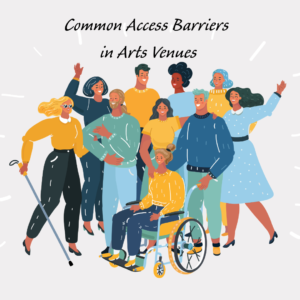Calling Up Justice believes in removing access barriers in visual and performing arts venues. Sometimes organizations are unaware of their access barriers. It can be very helpful to have a needs assessment organized by an outside consultant. Read below about specific deficits your space might want to alleviate.
Physical Barriers
- Inadequate Wheelchair Accessibility:
- Lack of ramps or elevators.
- Inaccessible seating arrangements.
- Inaccessible restrooms.
- Poor Signage:
- Lack of clear, easily readable signs directing to accessible entrances, exits, and facilities.
- Insufficient tactile or Braille signage for visually impaired visitors.
- Limited Parking:
- Insufficient accessible parking spaces close to venue entrances.
- Inaccessible Stages and Exhibit Areas:
- Stages or exhibit areas without ramps or lifts for performers and visitors with mobility issues.
Sensory Barriers
- Inadequate Assistive Listening Devices:
- Lack of hearing loops, FM systems, or other assistive listening devices for the hearing impaired.
- Insufficient Sign Language Interpretation:
- Lack of ASL interpreters for performances or guided tours.
- Lack of Audio Descriptions:
- No audio descriptions available for visually impaired patrons during performances or exhibitions.
- Poor Lighting and Acoustics:
- Poorly lit areas and poor acoustics making it difficult for people with visual or hearing impairments to navigate or enjoy the experience.
Communication Barriers
- Lack of Information in Accessible Formats:
- Absence of programs, guides, or promotional materials in large print, Braille, or accessible digital formats.
- Inaccessible Ticketing Systems:
- Websites or ticketing services that are not compatible with screen readers or do not provide easy access for those with disabilities.
Attitudinal Barriers
- Staff Unawareness or Lack of Training:
- Staff who are not trained to assist or are unaware of the needs of patrons with disabilities.
- Discriminatory Practices:
- Negative attitudes or assumptions about the abilities of people with disabilities.
Financial Barriers
- High Ticket Prices:
- High cost of tickets or additional fees for accessible seating can be prohibitive for some people with disabilities.
Social Barriers
- Lack of Outreach and Inclusion:
- Inadequate efforts to engage and include people with disabilities in arts programming and marketing.
- Limited Program Diversity:
- Lack of performances or exhibitions that are inclusive or reflective of the experiences of people with disabilities.
Addressing these barriers involves creating a more inclusive environment through thoughtful design, staff training, and a commitment to accessibility in all aspects of arts programming and venue management. We like to use “Disability Justice: An Audit Tool,” written by Leah Lakshmi Piepzna-Samarasinha and envisioned by Stacey Park Milbern and Leah Lakshmi Piepzna-Samarasinha. “Disability Justice: An Audit Tool” is aimed at helping Black, Indigenous and POC-led organizations (that are not primarily focused around disability) examine where they’re at in practicing disability justice, and where they want to learn and grow. It includes questions for self-assessment, links to access tools, organizational stories and more.

